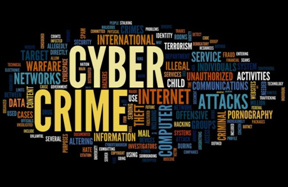



 Disclaimer: Copyright infringement not intended.
Disclaimer: Copyright infringement not intended.Cybercrime is defined as a crime where a computer is the object of the crime or is used as a tool to commit an offense. A cybercriminal may use a device to access a user’s personal information, confidential business information, government information, or disable a device. It is also a cybercrime to sell or elicit the above information online.
|
Crimes that target networks or devices |
Crimes using devices to participate in criminal activities |
|
Viruses |
Phishing Emails |
|
Malware |
Cyberstalking |
|
DoS Attacks |
Identity Theft |
There are three major categories that cybercrime falls into: individual, property and government. The types of methods used and difficulty levels vary depending on the category.
|
DDoS Attacks
These are used to make an online service unavailable and take the network down by overwhelming the site with traffic from a variety of sources. Large networks of infected devices known as Botnets are created by depositing malware on users’ computers. The hacker then hacks into the system once the network is down.
Botnets
Botnets are networks from compromised computers that are controlled externally by remote hackers. The remote hackers then send spam or attack other computers through these botnets. Botnets can also be used to act as malware and perform malicious tasks.
Identity Theft
This cybercrime occurs when a criminal gains access to a user’s personal information to steal funds, access confidential information, or participate in tax or health insurance fraud. They can also open a phone/internet account in your name, use your name to plan a criminal activity and claim government benefits in your name. They may do this by finding out user’s passwords through hacking, retrieving personal information from social media, or sending phishing emails.
Cyberstalking
This kind of cybercrime involves online harassment where the user is subjected to a plethora of online messages and emails. Typically cyberstalkers use social media, websites and search engines to intimidate a user and instill fear. Usually, the cyberstalker knows their victim and makes the person feel afraid or concerned for their safety.
Social Engineering
Social engineering involves criminals making direct contact with you usually by phone or email. They want to gain your confidence and usually pose as a customer service agent so you’ll give the necessary information needed. This is typically a password, the company you work for, or bank information. Cybercriminals will find out what they can about you on the internet and then attempt to add you as a friend on social accounts. Once they gain access to an account, they can sell your information or secure accounts in your name.
PUPs
PUPS or Potentially Unwanted Programs are less threatening than other cybercrimes, but are a type of malware. They uninstall necessary software in your system including search engines and pre-downloaded apps. They can include spyware or adware, so it’s a good idea to install an antivirus software to avoid the malicious download.
Phishing
This type of attack involves hackers sending malicious email attachments or URLs to users to gain access to their accounts or computer. Cybercriminals are becoming more established and many of these emails are not flagged as spam. Users are tricked into emails claiming they need to change their password or update their billing information, giving criminals access.
Prohibited/Illegal Content
This cybercrime involves criminals sharing and distributing inappropriate content that can be considered highly distressing and offensive. Offensive content can include, but is not limited to, sexual activity between adults, videos with intense violent and videos of criminal activity. Illegal content includes materials advocating terrorism-related acts and child exploitation material. This type of content exists both on the everyday internet and on the dark web, an anonymous network.
Online Scams
These are usually in the form of ads or spam emails that include promises of rewards or offers of unrealistic amounts of money. Online scams include enticing offers that are “too good to be true” and when clicked on can cause malware to interfere and compromise information.
Exploit Kits
Exploit kits need a vulnerability (bug in the code of a software) in order to gain control of a user’s computer. They are readymade tools criminals can buy online and use against anyone with a computer. The exploit kits are upgraded regularly similar to normal software and are available on dark web hacking forums.
© 2024 iasgyan. All right reserved